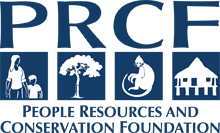People Resources and Conservation Foundation
 | |
| Founded | 1995 |
|---|---|
| Founder | Fernando and Marla Potess |
| Type | NGO, non-membership organization incorporated under Section 501(c)(3) of the United States Internal Revenue Code |
| Focus | Environmentalism, Conservation organization |
Area served | Southeast Asia, Asia Pacific |
| Slogan | Working with people to protect their natural environment |
| Website | prcfoundation.org |
People Resources and Conservation Foundation (PRCF) is an international non-governmental organization that helps local people in developing countries protect their natural environment. Its headquarters are in the United States[1] but its conservation fieldwork is carried out in a number of Southeast Asian countries. PRCF has joined collaborative research projects on new animal species in Southeast Asia, such as the Myanmar/Burmese snub-nosed monkey. The organization also sets up programs to help native cultures retain their cultural identity through projects such as basket and fabric weaving.
Mission
PRCF’s stated mission is to ‘conserve biodiversity, ecosystem services and local cultural identities through participatory solutions that protect and promote the wise use of natural resources, support socioeconomic development of communities and enable effective adaptation to climate change’.[2] The organization is concerned with endangered species (species assigned an IUCN category of threat) and loss of their critical habitat, land degradation and climate change. It also works with local communities to promote sustainable livelihoods, participatory land use planning and the revitalization of traditional cultural arts.[3]
History
The organization was founded in 1995[4] by two biologists-cum-conservationists from the United States and Colombia, Marla and Fernando Potess. In 1995 the first of the PRCF country programs – PRCF Indonesia – was established, with conservation and community development projects based in West Kalimantan, an Indonesian province on the island of Borneo.[5] Other country programs were later established in Cambodia,[6] Myanmar/Burma,[7] Vietnam[8] and Thailand.
Funding
PRCF is a nonprofit foundation,[9] receiving gifts and donations from individuals as well as grants from private and government organizations. In 2010, PRCF derived funding as follows: 15% from the public, 63% from private sources (such as the McKnight Foundation) and 22% from government sources (such as the United States Fish and Wildlife Service [USFWS]). Major donors to PRCF during 2010 were the Arcus Foundation and the Critical Ecosystem Partnership Fund (CEPF).[10][11]
Conservation work
PRCF works collaboratively with local communities and government authorities at field sites. It also partners with national and international conservation organizations including the Biodiversity and Nature Conservation Association (BANCA) in Myanmar, the Kobus Foundation in Indonesia, BirdLife International[12] in Cambodia and Fauna & Flora International[13] in Myanmar, Vietnam and Indonesia.
In 2010 PRCF was a member of a joint survey team, led by BANCA’s Ngwe Lwin, that discovered a new primate species in northern Myanmar: the Burmese Snub-nosed Monkey (Rhinopithecus strykeri).[14] The species was named in honor of Jon Stryker, President and Founder of the Arcus Foundation.[15] His grant to PRCF helped lead to the discovery of the species.
As of June 2012, PRCF and partners have worked to protect 16 endangered or threatened species in Southeast Asia. These include the critically endangered White-shouldered Ibis (Pseudibis davisoni)[16] and Tonkin Snub-nosed Monkey (Rhinopithecus avunculus)[17] plus the endangered Western Hoolock Gibbon (Hoolock hoolock)[18] and Francois’ Langur (Trachypithecus francoisi).[19][20]
References
- ↑ GuideStar Quick View: People Resources and Conservation Foundation. http://www.guidestar.org/organizations/75-2641707/people-resources-conservation-foundation.aspx
- ↑ About the People Resources and Conservation Foundation. http://www.prcfoundation.org/about-us/
- ↑ Sutton, Nicola. Weaving a Future: PRCF helps Dayak women fight Environmental Destruction. Youth Leader: The Asian Region http://www.asia.youth-leader.org/?p=5041
- ↑ People Resources and Conservation Foundation - About us - History. http://www.prcfoundation.org/about-us/history/
- ↑ Welcome to PRCF Indonesia. http://www.prcfoundation.org/countries/indonesia/
- ↑ Maltby, Matthew and Bourchier, Gavin. Current Status of Asian Elephants in Cambodia. Gajah 35 (2011) 36-42 http://www.asesg.org/PDFfiles/2012/35-36-Maltby.pdf
- ↑ Looking out for the Myanmar snub-nosed monkey May 25, 2012 Phys.org. http://phys.org/news/2012-05-myanmar-snub-nosed-monkey.html
- ↑ Stout, David. A green breakthrough? The Word Ha Noi, November 2011: 34-43.
- ↑ GreatNonprofits (2012. People Resources and Conservation Foundation. http://greatnonprofits.org/reviews/people-resources-and-conservation-foundation/#r_id-111176--user_id-151318
- ↑ Critical Ecosystem Partnership Fund: Partners. http://www.cepf.net/partners/Pages/default.aspx
- ↑ Critical Ecosystem Partnership Fund. Indo-Burma (Indochina Region) Project Database. http://www.cepf.net/grants/project_database/indo-burma/Pages/default.aspx
- ↑ BirdLife International in Indochina. Non-government organizations. http://birdlifeindochina.org/content/useful-links
- ↑ Fauna & Flora International (2012). Genetic study sheds light on evolution and may help prevent extinction of the Myanmar snub-nosed monkey.
- ↑ Geissmann, T, Lwin, N, Aung, SS, Aung, TN, Aung, ZM, Hla, TH, Grindley, M and Momberg, F (2011). A new species of snub-nosed monkey, genus Rhinopithecus Milne-Edwards, 1872 (Primates, Colobinae), from northern Kachin state, northeastern Myanmar. American Journal of Primatology, 73: 96–107. doi: 10.1002/ajp.20894 http://onlinelibrary.wiley.com/doi/10.1002/ajp.20894/full
- ↑ Our Founder. Arcus Foundation. http://www.arcusfoundation.org/conservation/about_us/our_founder/
- ↑ Largest ever White-shouldered Ibis count (2010). BirdLife International in Indochina http://birdlifeindochina.org/content/largest-ever-white-shouldered-ibis-count
- ↑ Tonkin snub-nosed monkey. ARKive: Images of life on earth. http://www.arkive.org/tonkin-snub-nosed-monkey/rhinopithecus-avunculus
- ↑ Geissmann T, Grindley M, Momberg F, Lwin N, Moses S (2008). Hoolock gibbon and biodiversity survey and training in southern Rakhine Yoma, Myanmar: preliminary report. Yangon: Myanmar Primate Conservation Program, BANCA, FFI, PRCF and Yangon University. http://onlinelibrary.wiley.com/doi/10.1002/ajp.20894/full
- ↑ Save Our Species. Sustainably funded community-based conservation of the largest known remaining population of the Francois’ Langur http://www.sospecies.org/sos_projects/mammals/francoislangur
- ↑ Community-based planning of the Lam Binh Forest Area Francois‘ Langur Conservation Landscape, Tuyen Quang Province, Vietnam. Critical Ecosystem Partnership Fund. Indo-Burma (Indochina Region) Project Database. Strategic Direction 1: Safeguard priority globally threatened species in Indochina by mitigating major threats. http://www.cepf.net/grants/project_database/indo-burma/Pages/strategic_direction_1.aspx